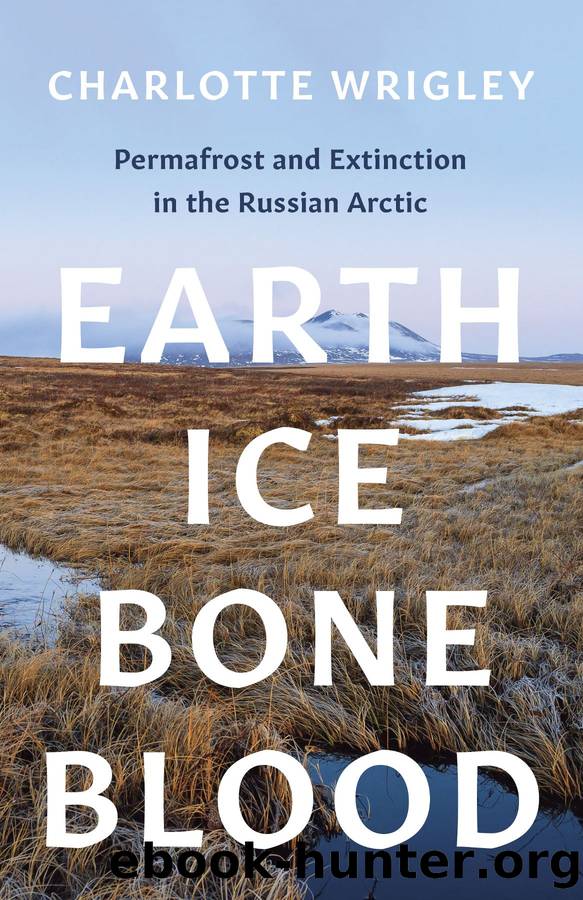Earth, Ice, Bone, Blood: Permafrost and Extinction in the Russian Arctic by Charlotte Wrigley

Author:Charlotte Wrigley [Wrigley, Charlotte]
Language: eng
Format: epub
Tags: SCI075000 SCIENCE / Philosophy & Social Aspects, SCI092000 SCIENCE / Global Warming & Climate Change, NAT045000 NATURE / Ecosystems & Habitats / General
Publisher: University of Minnesota Press
Published: 2023-04-04T00:00:00+00:00
It is clear that Nikita and his father hold a dim view of the actions of humans in the past, and that they extend this opinion to early humans living alongside mammoths. Nikita goes on to explain that he and Sergey are not claiming that humans slaughtered every last creature, just that they killed enough to cause the ecosystem to change from a highly nutritious grassland to a scrubby tundra with very little to eat. The animals could no longer survive there. The discrepancy in mammoth populations is often pointed to as supporting evidence for Pleistocene overkill: that mammoths died out on the mainland a full four thousand years before they did on isolated islands like Wrangel appears to bolster the claim that humans were at least partly responsible for this extinction event. Or, as Nikita proffers casually: âIf you kill a mammoth, youâre the sexiest guy in the land, all the chicks are yours.â
Nikitaâs flippant remark is indicative of something deeper that informs both his and his fatherâs understanding of ecology and predation. It is an understanding that is found throughout much of rewilding discourse: that not only do humans not belong in nature, but they actively cause it harm.27 Ironically, rewilding in the vein of the Pleistocene Park occupies a space in the so-called good Anthropocene, in which humans maintain control of the planet by removing themselves from a nature that will fix it for them. Whether the Pleistocene overkill hypothesis is correct or not is beyond my purview as a humanities scholar; I lack the required expertise to make a claim on either side of the debate (although it seems most likely that a combination of overkill and climate change is responsible for the extinction). However, my intention is not to interrogate this hypothesis scientifically, but merely to attempt to understand the logic and rationale of these two scientists who subscribe so fully to it. The discovery of the bones at Duvanny Yar meant that the Zimovs were confronted with a defunct ecosystem rendered visible by permafrost thaw; in their eyes, it is a product of humanityâs destructive prowess.
This defunct ecosystemâwith its vast expanse of prehistoric animal bones belonging to creatures that once shaped and maintained a grassy steppeâcontrasts sharply with the scrubby tundra found today, which supports very few animal species. These bones do not invoke human memoryâthey are simply too oldâbut a sense of anxiety emerges when one is confronted with such massive evidence of extinction, the possible catastrophic futures wrought through permafrost retreat, and the release of greenhouse gases colliding with the tangible and material reminders of a lost past.28 These animal remains gnaw at the physical reality that the working ecosystem of the mammoth steppe is no longer there and generate imaginaries around the potential consequences of ecological ruin.29 But what also emerges from this encounter is a sort of imagined nostalgiaâa pieced-together memorial collage of a balanced ecosystem lost to the destructive potential of humanity.30 Much of the discourse around rewilding hinges
Download
This site does not store any files on its server. We only index and link to content provided by other sites. Please contact the content providers to delete copyright contents if any and email us, we'll remove relevant links or contents immediately.
The Lonely City by Olivia Laing(4751)
Animal Frequency by Melissa Alvarez(4397)
All Creatures Great and Small by James Herriot(4233)
Walking by Henry David Thoreau(3897)
Exit West by Mohsin Hamid(3779)
Origin Story: A Big History of Everything by David Christian(3651)
COSMOS by Carl Sagan(3559)
How to Read Water: Clues and Patterns from Puddles to the Sea (Natural Navigation) by Tristan Gooley(3409)
Hedgerow by John Wright(3280)
The Inner Life of Animals by Peter Wohlleben(3261)
How to Read Nature by Tristan Gooley(3250)
How to Do Nothing by Jenny Odell(3235)
Project Animal Farm: An Accidental Journey into the Secret World of Farming and the Truth About Our Food by Sonia Faruqi(3178)
Origin Story by David Christian(3149)
Water by Ian Miller(3129)
A Forest Journey by John Perlin(3027)
The Plant Messiah by Carlos Magdalena(2883)
A Wilder Time by William E. Glassley(2818)
Forests: A Very Short Introduction by Jaboury Ghazoul(2793)
